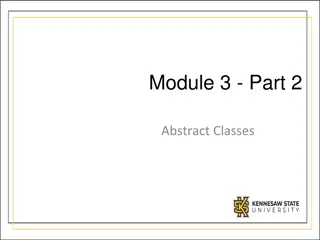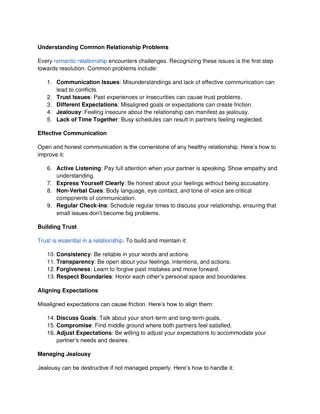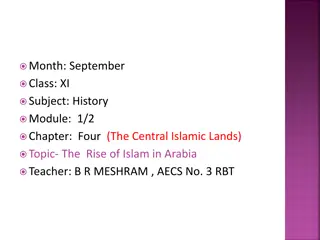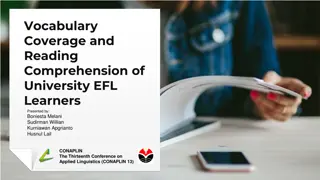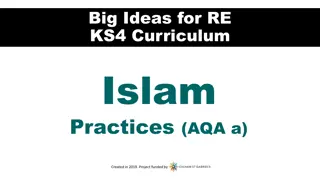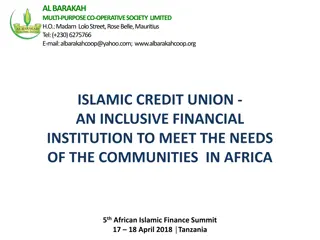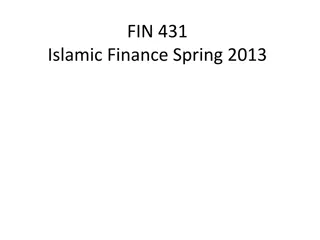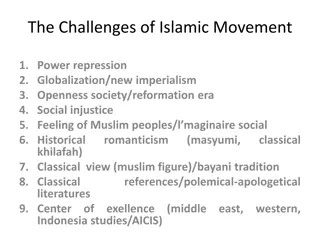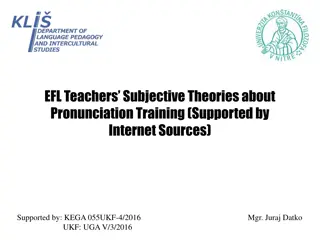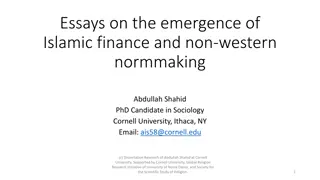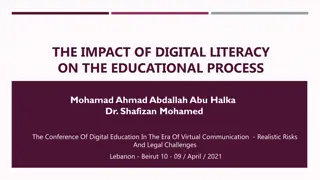Exploring Digital Literacy in Online EFL Classes at an Islamic Junior High School
The research delves into the implementation of digital literacy skills among students in an online EFL class at an Islamic junior high school in Indonesia. Utilizing various digital tools and applications such as WhatsApp and Zoom, both teachers and students incorporate cultural, cognitive, communicative, and critical digital literacy elements in their online learning experiences.
Download Presentation

Please find below an Image/Link to download the presentation.
The content on the website is provided AS IS for your information and personal use only. It may not be sold, licensed, or shared on other websites without obtaining consent from the author. Download presentation by click this link. If you encounter any issues during the download, it is possible that the publisher has removed the file from their server.
E N D
Presentation Transcript
DIGITAL LITERACY IN 21STCENTURY: A PORTRAYAL OF AN ONLINE EFL CLASS IN INDONESIA Mela Nurmala Farouk Imam Arrasyid Zakky Yavani IAIN Syekh Nurjati Cirebon
INTRODUCTION The domination of technology in daily lives highlights the importance of digital literacy for people all over the world. During pandemic, teaching and learning process shifted to online learning. Digital literacy is vital that every human being should master in the 21stcentury (Suhendra, Iswara & Sartono, 2019, p. 1214).
Introduction Technological advances allow students to easily access digital literacy. However, in an Islamic junior high school, it was found that there are several students who had difficulty in experiencing digital literacy. Therefore, the current research intends to explore how the implementation of digital literacy skills of Islamic Junior High School students and what factors are needed to develop digital literacy in online EFL classes.
METHOD This qualitative case study approach using the collection techniques; study employed a Data analysis was conducted as follows; Adapted from Creswell (2009, p. 185) 1) Preparing and Organizing the Data 2) Reviewing the Data 3) Constructing descriptions 4) Reporting and Interpreting the Data following data Interview Observation Documentation
FINDINGS AND DISCUSSION how is the implementation of digital literacy skills of Islamic Junior High School students in online EFL classes? Both teacher and students utilized various applications on their gadgets such as WhatsApp, Zoom Cloud Meeting, YouTube, Learning Management System (LMS) and online quiz platform in conducting online learning. Students performed several digital literacy elements (cultural, cognitive, communicative and critical) in English online learning.
Findings and Discussion Cultural element of digital literacy includes the ability to move appropriately between different digital environments (Belshaw, 2014, p. 46). The cultural element is involved when the teachers ask the students to use a variety of digital tools while also being able to customize how they interact within these tools. For example, the way people communicate on WhatsApp group chat should be different from how they chat with their friends on WhatsApp personal chat. Cognitive element in digital literacy includes the ability to use multiple devices, software, platforms or even interfaces and the ability to recognize various common features across digital tools (Belshaw, 2014, p. 48). Students ability to utilize a range of digital tools is totally involved when both teacher and students used various devices as learning media in an online English classroom.
Findings and Discussion Communicative element covers the ability to communicate effectively using a particular digital tool and the ability to comprehend and apply certain norms and assumptions across digital tools (Belshaw, 2014, p. 50). During times of pandemic, the teacher utilizes the feature of group chat rooms as a means to communicate with their students. Therefore, to ensure the messages that they send are received correctly, it is significant for students to comprehend some common rules or norms in online communication. Critical element covers the ability to separate credible sources from less credible ones and the ability to find the content which is appropriate with the material (Belshaw, 2014, p. 56). This digital literacy element was involved when students receive and share any kind of information. Unfortunately, it showed that the students ability to ensure the trustworthiness of the information that they share seems like it has not been mastered by all the English students yet.
The students in an Islamic junior high school experienced some crucial barriers when implementing digital literacy in English classrooms. The barriers are; 1) The school has insufficient support in internet connectivity. 2) Some students are not ready to access technology since they do not have technology sources such as gadgets, poor internet connection, and lack the ability to utilize technologies. Not all students have the skills in operating devices like gadgets to use as a medium in the English online learning process.
what factors are needed to develop digital literacy in online EFL classes? The availability of adequate school Infrastructures; the school facility has crucial roles to play in solving problems of students' access to the school system and to enhance students digital literacy experiences. 1. 2. Teachers guidance; besides the school providing technologies that can accessed by all the students, it is no less important to involve students in discussion on digital literacy. Students require guidance or direction from their teachers regarding any aspects of digital literacy in order to enhance their digital literacy.
3. Immersed into digital environments; Hague & Payton (2010, p. 21) claimed that developing digital literacy in school context refers to provide the opportunity for all students to utilize digital technologies that support the encouragement of their digital literacy skills and help them to achieve their learning objectives. Therefore, students need to immersed into digital world to develop their digital literacy skills. As a result, it is necessary for teachers for organizing method of teaching that support the encouragement of students digital literacy.
CONCLUSION Students used various digital tools and performed several digital literacy elements (cultural, cognitive, and critical) in English online learning. Nevertheless, in the process of implementing digital literacy in English classroom, the students faced with several problems. Several things that needed by students to develop their digital literacy skills, including the availability of school infrastructures, the guidance from the teachers, environments. and involved in the digital
Thanks! CREDITS: This presentation template was created by Slidesgo, including icons by Flaticon, infographics & images by Freepik and illustrations by Stories.


